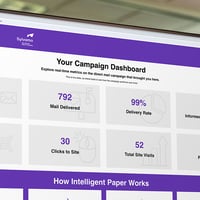Digital Dish: October 2019
Each dish features a new nugget to chew on and fuel your digital cravings. This month's edition addresses a frequently-asked topic on the longevity of using treated papers on digital printing equipment, including Indigo, high-speed inkjet and toner-based. Will treated papers ever go away? As digital printing continues its growth in the commercial printing community, it's an exciting time to see what the future holds for the industry!
INDIGO DIGITAL PRINTING
The first form of digital printing to discuss is HP® Indigo® printing, a unique type of printing that uses a special ink commonly referred to as Liquid Ink by HP Inc. This ink is a polymer ink suspended in mineral oil; therefore, in order for the polymer to bind to and grasp the paper, it requires a treated paper. The treatment is manufactured into the digital sheet so that it acts as a receptor for the polymer and helps the layers of liquid ink, which are added one color at a time, bond to the sheet. So, in the case of Indigo printing, using a treated sheet remains necessary. And as previously discussed in a digital dish, Sylvamo manufactures 3- and 2-star HP certified papers, treated specifically for Indigo presses.
HIGH-SPEED INKJET PRINTING
A second form of digital printing is high-speed production inkjet, which typically use water-based pigment inks. Among this category of printing is a wide offering of presses, and the Original Equipment Manufacturers (OEM) of these presses are constantly looking for ways to innovate. When it comes to inkjet, printing with treated media adds a beneficial component that helps the pigment ink remain on the surface of the sheet and the water disperse through the paper fiber and dry evenly. Sylvamo also manufacturers treated papers specifically for inkjet presses that results in incredible color and clarity. As part of the OEMs innovation efforts, they are exploring the development of inks that will enable presses to print on untreated media and still deliver crisp and colorful results. While some progress is being made, there continue to be presses in the market requiring treated media. Therefore, I do not see this going away anytime soon.
TONER-BASED DIGITAL PRINTING
The third form of digital printing is dry toner-based technology, which has existed for quite some time. Starting with Black & White only, it has since moved into full color printing that delivers fantastic results on untreated paper. Dry toner is a plastic pigment fused to the media using a high-heat fuser roll that melts the ink onto the substrate. These dry toners bond well to paper, so a treatment isn't necessary to make a media print well. The main type of substrates that experience issues on dry toner presses are synthetics due to the high 400º Fahrenheit heat of the fuser roll potentially melting the substrate and causing damage to the toner press.
HAPPY HALLOWEEN!
On behalf of Sylvamo, we want to wish you a Happy Halloween! And when it's time to print your next job, don't be scared to use Accent® Opaque. Visit our website to see a host of projects made possible with Accent!






